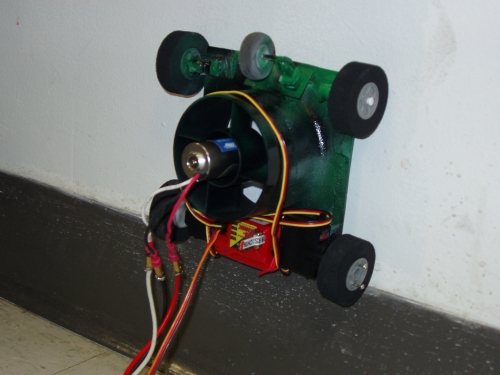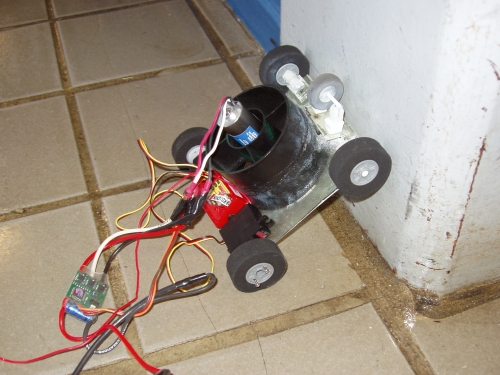



The Department of Defense along with Eglin Air Force Base and other government militaries have recently voiced a need for Small robotic Platforms for Limited Access Terrain, or SPLAT. Reliable surveillance is uncompromising in the world of urban warfare, but obtaining that reliable surveillance can often be dangerous to military personnel. For this reason, Eglin AFB has sponsored the SPLAT project. The goal of this project is to design subsystems that would give a small robotic platform the capability to transition from horizontal to vertical surfaces, and then have the ability to maneuver in that vertical plane.
In order to complete this project, the SPLAT team first set rules and guidelines for team dynamics and behavior. Background research was then done on already existing platforms. Next, ideas were generated and evaluated to determine the best overall design concept. The final concept chosen was a cart that utilized a blower/turbine as the means of adhesion to the wall. The thrust generated is large enough to cause sufficient lift and normal forces so the platform can remain on a vertical surface and maneuver on that surface. Once the final concept was chosen, the necessary components for that design were laid out, and the initial components were purchased. These included a ducted fan, a radio and receiver unit, and a speed control to vary the thrust of the fan. While the parts were on order, an initial design of the body was completed and the tests that were to be run were set out in detail.
The testing consisted of obtaining the fan/motor characteristics by utilizing a low-friction cart and a hanging mass. This determined the amount of thrust that the fan/motor was generating. The second test performed was a vertical wall test which consisted of placing the cart on a vertical surface and determining the payload that it could carry. From this test, it was determined that the maximum weight of the cart had to be less than ~13-14oz. The drive train was constructed and tested next. The final drive train consisted of two micro servomotors that were modified to produce continuous motion. The transition was accomplished by placing a 5th wheel in the center of the body and above the other wheels. This caused the front of the body to ride up the wall until the fan could be turned on. The final design is depicted in the picture above. The platform making horizontal to vertical transition is show below.

Small Robotic Platform